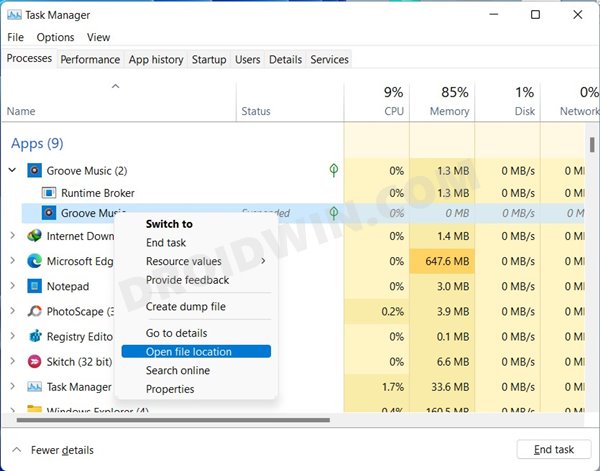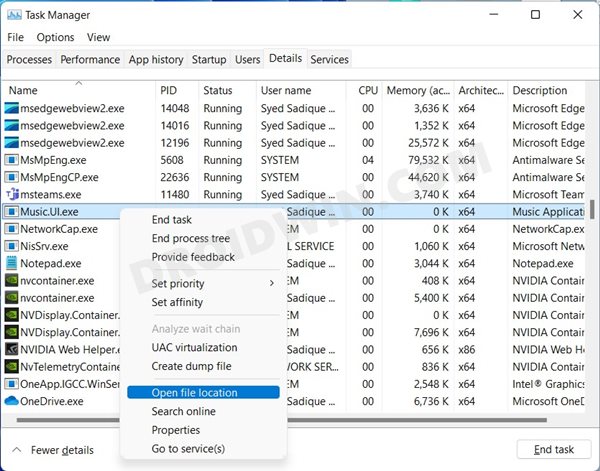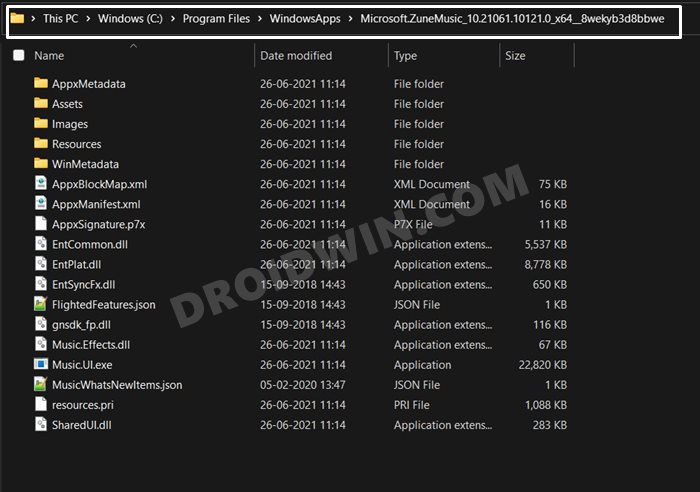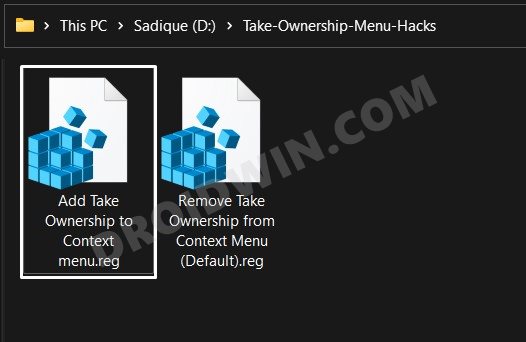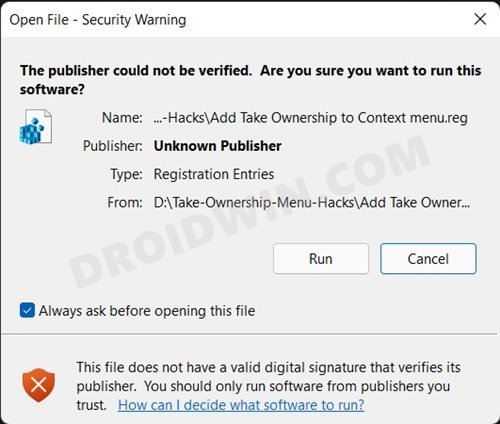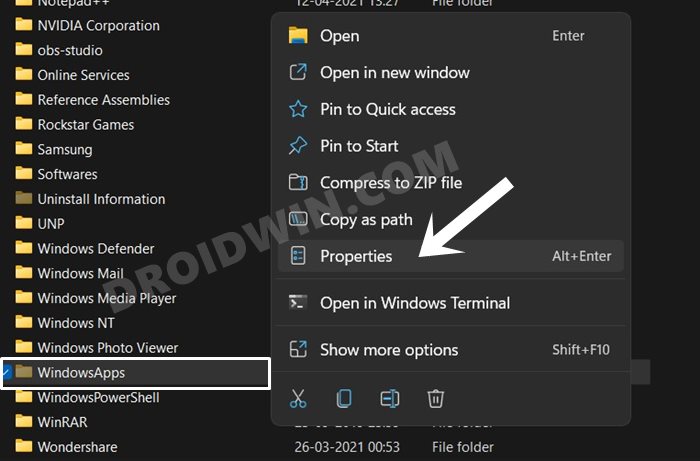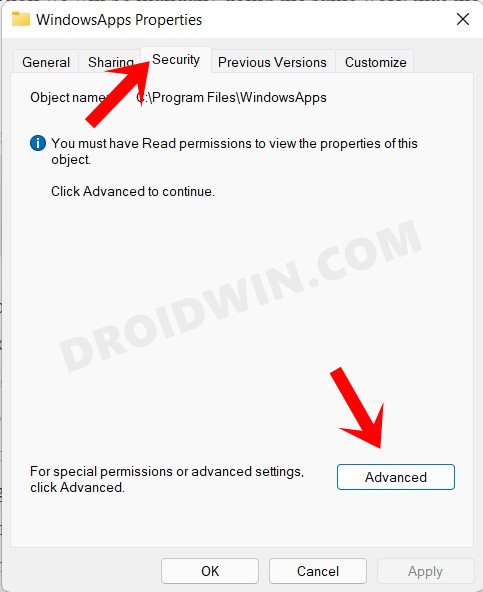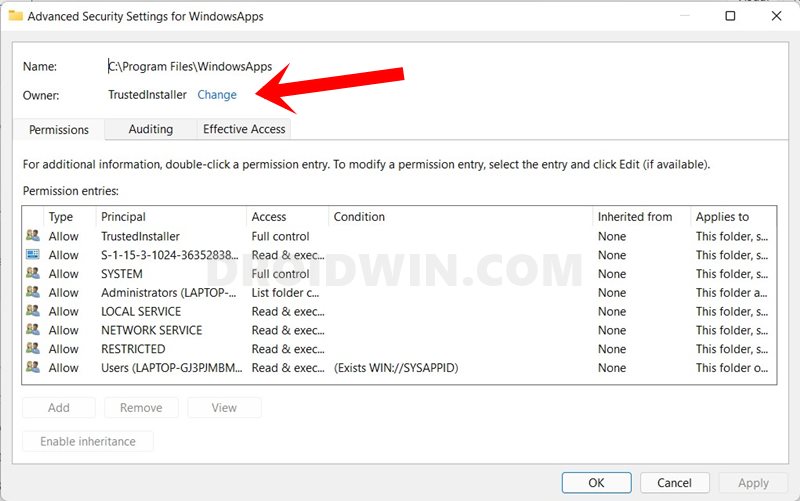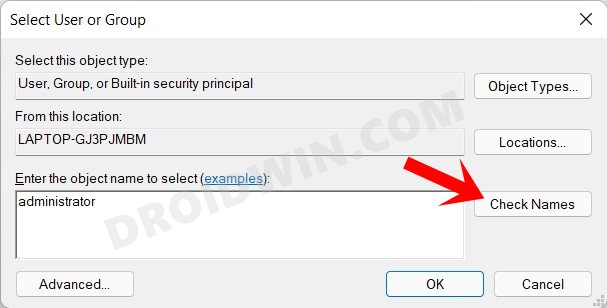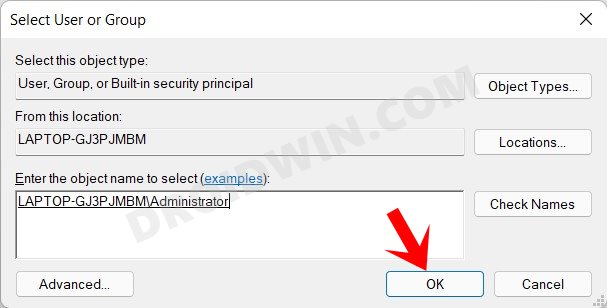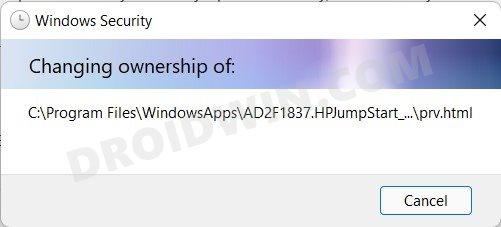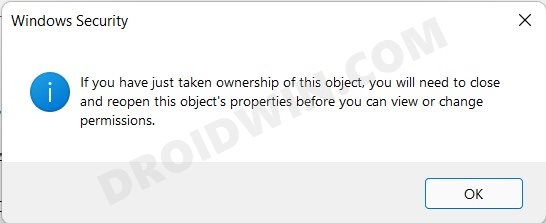You need to access the WindowsApps folder if you wish to take a backup of your Windows Apps or clear some space from the computer hard disk drive (HDD).
The Microsoft Windows operating system comes with some restricted and hidden folders that usually contain files that help run Windows 11 or 10 smoothly. Disturbing these files could result in system errors or complete Windows OS malfunction.
Some of these folders are Program Data, System32, AppData, WindowsApps, etc. Among these folders, WindowsApps is of particular interest since this drive use ups a lot of disk storage when you do not restrict app installations from Windows Store.
Let’s learn more about the WindowsApps folder, its purpose, and how to access the WindowsApps folder should you need to take backup or clear some disk space.
What Is the WindowsApps Folder?
The WindowsApps folder is available in Program Files of your Windows 10 or 11 OS installation directory and stores app files for Windows Apps. Since Windows 8 OS, Microsoft introduced a set of apps that function differently than conventional software.
In the past, Microsoft called these apps Metro-style apps, Windows Store apps, Universal Windows Platform (UWP) apps, and now simply Windows apps. Windows 10 or 11 OS stores Windows Apps and other UWP apps like Your Phone in the WindowsApps folder.

The folder is a highly secure location within your Windows OS installation directory and is protected by multiple layers of security. First of all, you will not see the folder unless you unhide it.
Secondly, normal user and system administrator user accounts do not have the necessary files access rights to access the folder or check its size, subfolders, files, etc. Microsoft reserved the necessary rights for the TrustedInstaller user account, which is a system account.
TrustedInstaller controls write and read access of the WindowsApps folder so that Windows Apps can smoothly function without any intervention from the user.
What Is the Purpose of the WindowsApps Folder?
WindowsApps folder is the safe house for all Windows apps that you install or come with the factory version of your Windows 10 or 11 OS copy. Here are the use cases of this folder:
Stores UWP Packages
Like the Program Files and Program Files (x86) for usual Windows PC software, WindowsApps is the default file location for all Windows apps or UWP packages. However, the subfolder naming convention is different than the Program Files.
For example, the Windows apps Netflix will have multiple folders with the following naming: app name, version number, CPU architecture (x64), and the Microsoft Store ID. More than one folder exists to differentiate the same app with different CPU architectures.
Works as Windows Apps Sandbox
Conventional Windows software like a data recovery tool or computer troubleshooter has the power to override system values and make visible changes in the Windows OS ecosystem. That’s why Windows features like User Account Control (UAC), user account rights, and Windows Security exists to keep them in check.

However, Windows apps can not make huge changes in the operating system. Microsoft achieved this by keeping these apps sandboxed inside the WindowsApps folder. These apps cannot themselves access computer hardware or data and need permissions in all the steps.
User Convenience
Most Windows apps do not come with executable files like the traditional software. Instead, they are a combination of automatic command prompt scripts and Java programs. Users may find it challenging to run such apps.
Also, users may make irreversible changes to these system files unknowingly if they can access the Windows apps files. Therefore, Microsoft Windows shows you app icons in the Start Menu and hides all the back-end data for safety and convenience.
How to Access WindowsApps Folder
There are multiple ways to access the WindowsApps folder. The steps are identical for both Windows 10 and Windows 11 operating systems.
Using the Task Manager Program
Accessing the WindowsApps folder for a specific app from the Task Manager program is the simplest way. It also takes less effort. However, you must run the target UWP (Universal Windows Platform) or Windows app in the background to access its folder. Here are the quick steps that you can follow on your Windows 11 pr 10 PCs:
Step #1: Run the UWP app or Windows app for which you want to access the WindowsApps folder. In this tutorial, it is the WhatsApp app. You can try this or try others like Netflix, Instagram, Skype, etc.
Step #2: To launch the Task Manager program, you can press this shortcut key: Ctrl+Shift+Esc. Alternatively, you can find the Task Manager folder by searching the Search Bar.

Step #3: Look for the app’s process in the Task Manager by scrolling the list or sorting it according to their names.
Step #4: Click on the drop-down arrow beside the app’s name to expand its processes. If there is no drop-down arrow, move on to the next step.

Step #5: Right-click on the app’s icon and select Open file location from the context menu that follows.
Step #6: Windows Explorer will take you to the sandboxed WindowsApps subfolder for the target app. In this case, the WhatsApp app.

Accessing the WindowsApps folder through the Task Manager gives you viewing permission. For example, you can go through all the files and folders of the UWP app and check their size. This step is good if you want to take a backup of the app’s files and folders.
The process does not let you delete or move files from the WindowsApps folder. To gain write and delete access, you need to follow any of the below-mentioned steps.
Using Windows File Explorer
The most practical and user-friendly way of gaining access into the WindowsApps folder is through the Windows File Explorer program. This process gives you a full read and write access to this folder. Thus, you can make any kind of change that you want.
This process is also reversible, should you need to restrict the access to the WindowsApps folder after making the changes you need. The File Explorer-based method has two phases. In the first phase, you need to unhide the WindowsApps folder.
In the second phase, you need to gain exclusive read and write rights of the folder by changing folder ownership. By default, Microsoft assigned the read and write permission to the TrustedInstaller user account of your Windows 10/11 computer. Without further ado, let’s unhide and take control of the folder of interest:
Step #1: Click on the File Explorer of the Taskbar to access This PC window.
Step #2: On the top ribbon, select View.
Step #3: You will see Options in the View menu. Click on that.
Step #4: Now, click on the Change folder and search options to open the Folder Options window.

Step #5: You will see three tabs in the Folder Options window. Select the one in the middle, the View tab.
Step #6: The View tab has two sections: Folder Views and Advanced Settings.
Step #7: In the Advanced Settings section, select the Show hidden files, folders, and drives option.

Step #8: Now, click the Apply button to save the changes.
Step #9: If you go to the Program Files folder in the Windows 11 installation directory, you should now find the WindowsApps folder in the unhidden state.

The WindowsApps folder is now visible. But, you can not access it yet. You need to manually take ownership of the folder to get read and write access.
For ownership changing purposes, you need a user account with administrative rights. If you are a non-admin user of your computer, you need to log out from that account. Then login again using the administrator account.

Once you are done switching the Windows user account, you can go ahead with the following steps for ownership transfer of the WindowsApps folder:
#1. Right-click on the WindowsApps folder and click on Properties.
#2. While on the Properties screen, click on the Security tab to reveal Advanced options. Click on Advanced.

#3. In the Advanced Security Settings for WindowsApps screen, click on Change.

#4. You will see the Select User or Group screen.
#5. In the Object Name field, enter the name of the user account of your PC that has administrative rights.
#6. You can simply write down the name of the user account in small letters. The system will automatically recognize it. However, you need to type the correct user name.
#7. Now, click on Check Names to populate the full user account address.

#8. Click Ok to apply the changes.
#9. You will now see your user account name in the Advanced Security Settings for WindowsApps window.
#10. Beneath your user account name, you will see a checkmark filed for Replace owner on sub containers and objects. Checkmark that box.

#11. Now click on Apply button and hit Ok to initiate the ownership change process.
#12. Once the process finishes, click Ok on the notification that follows.

#13. Refresh your PC and try to access the WindowsApps folder again from Program Files by double-clicking on it.

#14. You will get full access to the folder with read and write permissions.
You can now move or delete files from the WindowsApps folder if you have taken ownership of the WindowsApps folder using the process mentioned above. However, practice caution when making any changes in the subfolders. Because if you delete vital app files, the respective Windows app may not function anymore.
This step is particularly useful when you need to clean up disk space. If you have stopped using certain Windows apps or have uninstalled them, you can delete their back-end files from the WindowsApps folder to save disk space.
Using Windows Powershell
The Windows File Explorer-based ownership change process for the WIndowsApps folder is somewhat tricky. You need to follow the steps correctly, or you will waste valuable time.
There is an easy and automated process that you can also try by using Windows Powershell. It is a robust configuration and task automation program for Windows. All Windows operating system versions since Windows 7 come with this program.

Therefore, you can apply this process to take ownership of the target folder on both Windows 10 and Windows 11 computers. You also do not need to unhide hidden files, folders, and drives.
In situations where you can not take the risk of unhiding Windows system files, the Powershell-based method is a perfect choice. Here are the steps to execute a Powershell command that assigns the necessary permissions to you to access and change the WindowsApps folder:
Step #1: Click on the magnifying glass of your Windows 11 Search.
Step #2: Type in Powershell and wait for the app to come up.
Step #3: You will see the Windows Powershell app on the right side of the search console.

Step #4: The app will show options like Open, Run as administrator, Open file location, etc.
Step #4: Click on Run as administrator to open the program.

Step #6: Once the program is up and running, execute the following command. You can copy the below command and paste it as is in Powershell and hit Enter.
takeown /f “C:\Program Files\WindowsApps” /rStep #7: The Powershell command takeown restores file or folder ownership to the system administrator. Advanced users utilize this command to facilitate ownership transfer for batch files.
Step #8: After the takeown syntax, you need to use /f parameter to specify the file, folder, or directory name.
Step #9: The closing /r parameter tells Powershell to transfer ownership of all the files and subdirectories to the administrator.

Step #10: Powershell will take some time to transfer the ownership of the WindowsApps folder and its content to your administrator user account.
Step #11: A flashing cursor will show up when the process is complete.
The access you gain by executing the above process is similar to that of the Windows File Explorer-based method. You have just automated the process and eliminated unhiding of system files. Now you can backup, clear some space, or make changes in the Windows apps back-end files.
Final Words
Now that you have an in-depth understanding of the WindowsApps folder, you can make changes in your Windows 10 or 11 OS responsibly. Before deleting any files from this folder, it is necessary that you know the folder inside out so that you do not make any fatal mistake that could damage the entire operating system.
Should you face any Windows 10 issues and need some automatic tools to resolve those problems, you can check out these 7 repair tools to solve Windows 10 problems.
how to access windowsapps folder windows 11
Accessing the WindowsApps folder on Windows 11 can seem like a daunting task, but it’s quite manageable once you know the steps. This folder is usually hidden and protected due to the sensitive files it contains. However, with the right permissions and a little bit of tweaking, you can access it. Here’s a quick walkthrough to get you started.
The steps below will guide you on how to gain access to the WindowsApps folder, ensuring you can view and manage the files within it.
Step 1: Open File Explorer
Navigate to the root of the drive where Windows is installed, usually C:.
File Explorer is your gateway to all the files and folders on your computer. By starting at the root of the drive, you can easily locate the folders you need to access.
Step 2: Reveal Hidden Items
Click on the «View» tab and check the «Hidden items» box.
WindowsApps is a hidden folder, so you need to make sure you can see all hidden items. This setting will reveal any folders or files that are normally hidden from view.
Step 3: Navigate to Program Files
Find and double-click on the «Program Files» folder.
The WindowsApps folder is located within the Program Files directory. This folder contains essential system and application files.
Step 4: Gain Folder Permissions
Right-click on the WindowsApps folder, select «Properties,» go to the «Security» tab, and click «Advanced.»
You need to adjust the permissions of the WindowsApps folder to gain access. This step ensures you have the appropriate rights to view and modify the contents.
Step 5: Change Ownership
In the Advanced Security Settings, click «Change» next to the owner label, and enter your username. Click «OK» and then «Apply.»
Changing the ownership gives you full control over the folder. Make sure to apply the changes so they take effect immediately.
Step 6: Adjust Permissions
Back in the Security tab, click «Edit,» select your username, and check the «Full control» box. Click «OK» and «Apply.»
Granting full control ensures you can not only access but also modify the files within the WindowsApps folder as needed.
Once you have completed these steps, you’ll have full access to the WindowsApps folder. You can now view, edit, or manage the files within it according to your needs.
Tips for Accessing WindowsApps Folder Windows 11
- Backup Important Files: Before making any changes, ensure you have a backup of important files.
- Use Administrator Account: Ensure you are logged in with an account that has administrative privileges.
- Understand the Risks: Be aware that modifying system files can affect your system’s stability.
- Revert Changes if Needed: If something goes wrong, you can always revert the permissions to the default settings.
- Check for Updates: Sometimes, system updates can reset permissions, so check after an update.
Frequently Asked Questions
Why is the WindowsApps folder hidden?
The folder is hidden to protect system files from accidental modification or deletion.
Can accessing WindowsApps harm my system?
Yes, improper modifications can affect system stability, so proceed with caution.
Do I need admin rights to access WindowsApps?
Yes, administrative privileges are necessary to change permissions and access the folder.
What is stored in the WindowsApps folder?
It contains app files and data for applications installed from the Microsoft Store.
Can I revert the permissions back after accessing it?
Yes, you can change the ownership and permissions back to their default settings if needed.
Summary
- Open File Explorer.
- Reveal Hidden Items.
- Navigate to Program Files.
- Gain Folder Permissions.
- Change Ownership.
- Adjust Permissions.
Conclusion
Accessing the WindowsApps folder in Windows 11 may seem complex, but by following these straightforward steps, you can gain the necessary permissions to view and manage its contents. The folder contains essential files for applications from the Microsoft Store, so it’s hidden and protected by default. Remember to proceed with caution and backup important data before making changes.
Understanding how to access the WindowsApps folder can be incredibly useful for troubleshooting and managing installed applications. Whether you’re a tech enthusiast or just looking to solve a specific problem, these steps provide a clear pathway to accessing this crucial directory. For more detailed information on other related topics, consider exploring Microsoft’s official documentation or tech forums to expand your knowledge further. Accessing the WindowsApps folder Windows 11 might seem like peeling an onion with many layers, but once you get to the core, you’ll find it’s quite manageable.
Matt Jacobs has been working as an IT consultant for small businesses since receiving his Master’s degree in 2003. While he still does some consulting work, his primary focus now is on creating technology support content for SupportYourTech.com.
His work can be found on many websites and focuses on topics such as Microsoft Office, Apple devices, Android devices, Photoshop, and more.
In this guide, we will be sharing three different methods to open the WindowsApps folder in Windows 11. Generally, if you are having an administrator account on your PC, then you should be able to access all the system directories and files present inside the C Drive. However, in some instances, even being the administrator wouldn’t be sufficient enough to checkmark the required prerequisites.
The perfect example of the same is the inability of an admin to access the WindowsApps folder. Double-click on this folder and it will prompt you of insufficient privileges or in some cases, wouldn’t give out any notification as such. But why is the admin not able to access the contents of this folder? Well, this is because the WindowsApps folder is under the ownership of the built-in Microsoft user account called TrustedInstaller.
So if you are planning to access this folder, you will first have to transfer the ownership from the TrustedInstaller’s account over to your administrator account. And in this guide, we will show you three different methods to do the same. So follow along for the detailed instructions to open the WindowsApps folder in Windows 11.
- UWP Apps in Windows 11: Location, URI, Shortcut, Uninstall
- Where are the Windows 11 Default Icon Files Located
- How to Disable Online Search in Start Menu [Windows 11]
- How to Remove Ads in Windows 11
Table of Contents
Open the WindowsApps Folder in Windows 11 via Task Manager
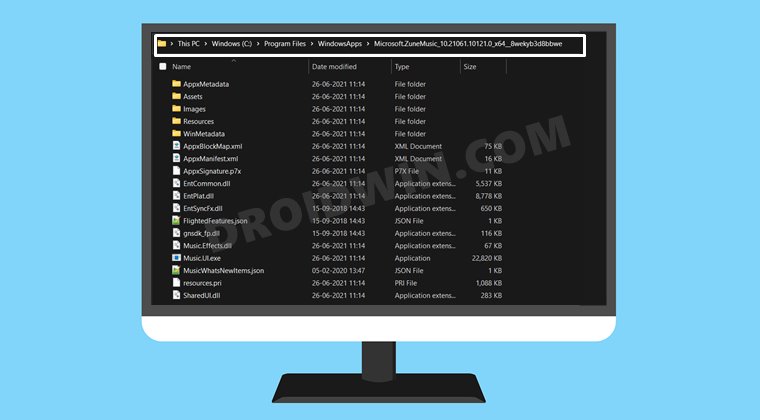
This first method is the least technical of the three but calls for maximum effort. In this method, we will be manually opening the desired UWP app so that its processes get up and running in the background.
Then we will use the Task Manager to access that process’ file location. Doing so shall then directly take us to the WindowsApps directory, inside that Windows app’s folder. So without further ado, let’s put this trick to the test.
Instruction Steps
- To begin with, head over to the Start Menu and launch the desired Windows Store/UWP app (say, Groovy Music).
- Then launch the Task Manager via Ctrl+Shift+Esc shortcut key combinations.
- Then go to the Processes tab and expand the Background Processes section.
- Now expand the app that you had just opened, right-click on any of its processes and select Open File Location.
- However, if the Open File Location option is greyed out, then select the “Go to Details” option from the right-click menu.
- This shall take you to the Details tab of Task Manager, with the process selected. Just right-click on it and select Open File Location.
- You shall now be taken to that concerned app’s folder inside WindowsApps. And that’s it, you have successfully accessed the desired folder.
Benefits
You don’t need to carry out any registry editor hacks or make use of a reg file. Likewise, the entire process was fairly simple.
Drawback
While this method was quite easy to execute, it does have a few drawbacks. First off, you will always have to open the app whose directory you need to access. And secondly, you will only be able to access that app’s directory only, you cannot hit the Back key and access any other app’s folder. As an example, I carried out this task using the Groove Music App and was hence taken to the following directory:
C:\Program Files\WindowsApps\Microsoft.ZuneMusic
Now I cannot hit the Back button and access the parent folder, which is the WindowsApps folder. So this method, at the very most, you could access the individual app’s directory only. To overcome this drawback, you should check out the below two methods to open the WindowsApps folder in Windows 11.
Open the WindowsApps Folder in Windows 11 via Registry Editor
This is the shortest and quickest method to carry out the aforementioned task. In this, you will just have to run a Registry Editor file which will help you to take ownership of the WindowsApps folder from the TrustedInstaller account.
Likewise, it also provides you the option to revert the changes. So once you are done using the WindowsApps folder, you could easily give the ownership back to TrustedInstaller. With that in mind, let’s get started.
Instruction Steps
- To begin with, download the Take Ownership Registry File [Credits: HowToGeek] and extract it to any convenient location on your PC.
- Then double click on the Add Take Ownership to Context Menu.reg file and click Run in the dialog box that appears.
- After that, click Yes in the Windows confirmation dialog box. The process will hardly take a few seconds.
- Once done you shall get the “Add Take Ownership to Context Menu.reg has been successfully added to the registry” message.
- Now launch File Explorer via Windows+E shortcut keys and head over to the below location
C:\Program Files
- Right-click on the WindowsApp folder and select Take Ownership. A CMD window will now open confirming the transfer of ownership.
- Once that is done, restart the PC. You shall now be able to able to open and access all the contents of the WindowsApps folder on your Windows 11 PC.
Benefits
First off, it only takes a minute or two to carry out the entire process. Moreover, you could easily revert the changes to the default state and give back the permission to the TrustedInstaller account as and when required. To do so, head over to the extracted Take Ownership Registry File and just run the Remove Take Ownership from Context Menu (Default).reg file.
Risks
Dealing with registry hacks could sometimes prove to be risky, even more so when the publishers aren’t verified. So you will have to exert caution when trying out this tweak.
Open WindowsApps Folder in Windows 11 by Manually Taking Ownership
As is evident from the heading, in this section we will be manually doing the same work that the Registry Editor file did for us in the second method. Follow along.
Instructions Steps
- To begin with, launch File Explorer via Windows+E and go to the below location:
C:\Program Files
- Now right click on the WindowsApps folder and select Properties.
- Go to the Security tab and then click on the Advanced button situated at the bottom.
- Then click on the Change button next to Owner: TrustedInstaller.
- Under the “Enter Object Names to select” field, type in administrator and click on the Check Names button.
- It shall now bring up your PC’s Administrator name, click OK to continue ahead.
- You shall now see the Owner being changed from TrustedInstaller to your administrator account.
- Now, check-mark the “Replace owner on sub containers and objects” option situated just beneath the Owner field.
- Finally, click Apply > OK to save the changes. Windows will now begin the process of transferring the ownership.
- Once done, you shall get a notification something along the lines of “If you have just taken ownership of this object…..”. Hit OK to close it.
- That’s it. You will now be able to open and access the WindowsApps folder on your Windows 11 PC.
Benefit
Unlike the first method, you will be able to access the entire directory and not just be limited to a particular app. Moreover, this method doesn’t require you to tweak any registry editor setting.
Drawback
This is quite a lengthy method and calls for maximum effort out of the three approaches that we have shared here.
Conclusion: Easily Access the WindowsApps Folder!
So with this, we round off the guide on how you could open the WindowsApps folder on your Windows 11 PC. We have shared three different methods for the same. Likewise, we have also listed the perks and caveats of each of these three methods. Do let us know in the comments section which method you ultimately decided to settle for. Likewise, all queries are welcomed in the comments below.
- How to Remove Evaluation Copy Watermark from Windows 11
- [5 Methods] How to Disable or Uninstall OneDrive in Windows 11
- Uninstall Apps using Command Prompt (CMD) or Powershell in Windows 11
- How to Change Refresh Rate in Windows 11
Accessing the WindowsApps folder in Windows 11 can feel like trying to crack open a digital safe. This folder is where Windows stores apps you get from the Microsoft Store. If you want to make changes, see what’s inside, or solve some issue, you’ll need to follow a few steps to get in. This quick guide will show you exactly how to do it, step-by-step.
Gaining access to the WindowsApps folder isn’t just a one-click affair; you’ll need to change some permissions. Here’s how you can get the job done.
Step 1: Open File Explorer
Start by opening File Explorer. You can do this by pressing the Windows key + E or by clicking the folder icon on the taskbar.
Once File Explorer is open, navigate to the C: drive or the drive where Windows is installed. You’ll usually find the WindowsApps folder in the «Program Files» directory.
Step 2: Enable Hidden Items
Go to the View tab in File Explorer and check the «Hidden items» box.
The WindowsApps folder is hidden by default, and this step makes it visible. If you skip this, you won’t see the folder at all.
Step 3: Locate the WindowsApps Folder
Navigate to the “Program Files” folder, where you should now see the WindowsApps folder.
At this point, you might get an error saying you don’t have permission to access the folder. Don’t worry, that’s what the next steps will fix.
Step 4: Change Folder Permissions
Right-click on the WindowsApps folder, and select «Properties.» Go to the «Security» tab, and click on «Advanced.»
This is where you’ll start the process of changing ownership. You need to have administrative privileges to proceed.
Step 5: Change Ownership
In the Advanced Security Settings window, click on the «Change» link next to the owner. Enter your username, click «Check Names,» and then hit OK.
This step transfers ownership of the folder from the system to you. Once you’ve done this, you can grant yourself full access.
Step 6: Grant Full Control
Go back to the Security tab, click «Edit,» select your user account, and then check the «Full control» box. Hit «Apply» and «OK.»
Now, you should have full access to the WindowsApps folder. You can open it, view its contents, and make changes if needed.
Once you’ve completed all the steps, you’ll have full access to the WindowsApps folder. You can explore its contents, troubleshoot issues, or modify files as needed.
Tips for Accessing WindowsApps Folder in Windows 11
- Double-check your user account is an administrator before you begin.
- Always back up important files before making changes in system folders.
- Use the «Take Ownership» context menu shortcut for faster access.
- If you face issues, consider using third-party tools for easier access.
- Make sure your Windows is up to date to avoid security vulnerabilities.
Frequently Asked Questions
Why can’t I see the WindowsApps folder?
The folder is hidden by default. You need to enable «Hidden items» in File Explorer.
Is it safe to change permissions for the WindowsApps folder?
Changing permissions is generally safe if you are careful, but always back up important data first.
Can I move the WindowsApps folder to another drive?
It’s not recommended as it could break app functionality. Use built-in Windows options to change app storage locations instead.
What if I can’t change the folder permissions?
Ensure you are using an administrator account. If problems persist, consider booting into Safe Mode.
Why do I need access to the WindowsApps folder?
You may need access for troubleshooting, modifying app files, or resolving permission issues.
Summary of Steps
- Open File Explorer.
- Enable Hidden Items.
- Locate the WindowsApps Folder.
- Change Folder Permissions.
- Change Ownership.
- Grant Full Control.
Conclusion
Accessing the WindowsApps folder in Windows 11 might seem daunting at first, but it’s entirely doable with the right steps. Once you’re in, you can manage your apps more effectively, troubleshoot problems, or just satisfy your curiosity about what’s going on under the hood.
Remember to always proceed with caution, especially when dealing with system files. This folder is part of the core structure of Windows, so any changes you make can have a significant impact. If you’re unsure about something, do a bit more research or ask for help.
For further reading, consider diving into Windows 11’s security settings or exploring other hidden folders that can help you manage your system more effectively. Now that you know how to access the WindowsApps folder, you’re one step closer to mastering Windows 11.
Kermit Matthews is a freelance writer based in Philadelphia, Pennsylvania with more than a decade of experience writing technology guides. He has a Bachelor’s and Master’s degree in Computer Science and has spent much of his professional career in IT management.
He specializes in writing content about iPhones, Android devices, Microsoft Office, and many other popular applications and devices.
Read his full bio here.
Вам нужен доступ к файлам приложения, установленного из магазина Microsoft Store? Вот краткое руководство, которое поможет вам в этом процессе.
Приложения Microsoft Store работают как любое другое приложение в вашей системе. Однако при установке они хранятся в отдельной директории. По умолчанию место установки приложений Microsoft Store не отображается.
Приложения, загруженные из Microsoft Store, сохраняются на диске, где установлена Windows в каталоге «Program Files» папка «WindowsApps». Эта папка по умолчанию скрыта, но, при желании, можно легко получить доступ к ее содержимому.
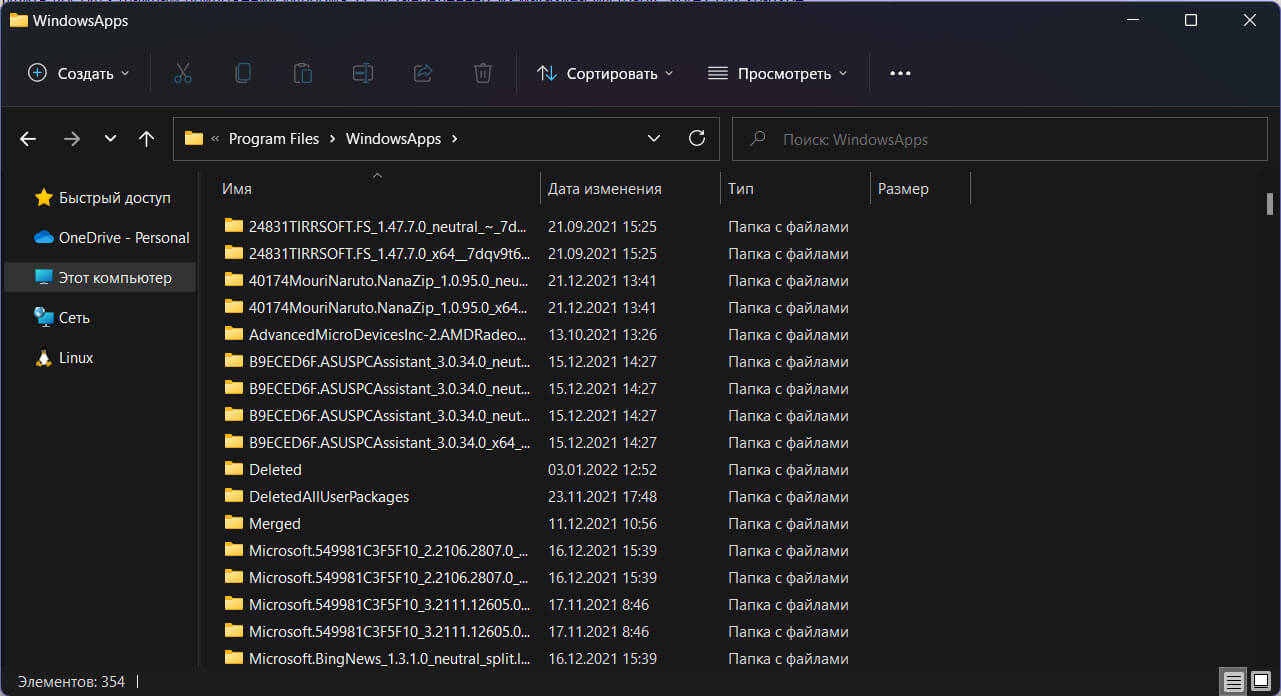
Обычному пользователю может показаться, что включение отображения скрытой папки может нанести вред системным файлам, но это не так; многие папки скрыты, потому что содержат техническую информацию, которая не нужна обычному пользователю, либо содержат отчеты о сбоях или другие диагностические данные, которые опять же не очень полезны если вы не продвинутый пользователь.
Как в Windows 11 открыть папку «WindowsApps» и стать ее владельцем
Шаг 1: Чтобы отобразить папку «WindowsApps», содержащую установочные файлы приложений Microsoft Store, откройте «Этот компьютер», в проводнике Windows, вы можете использовать сочетание клавиш Win E.
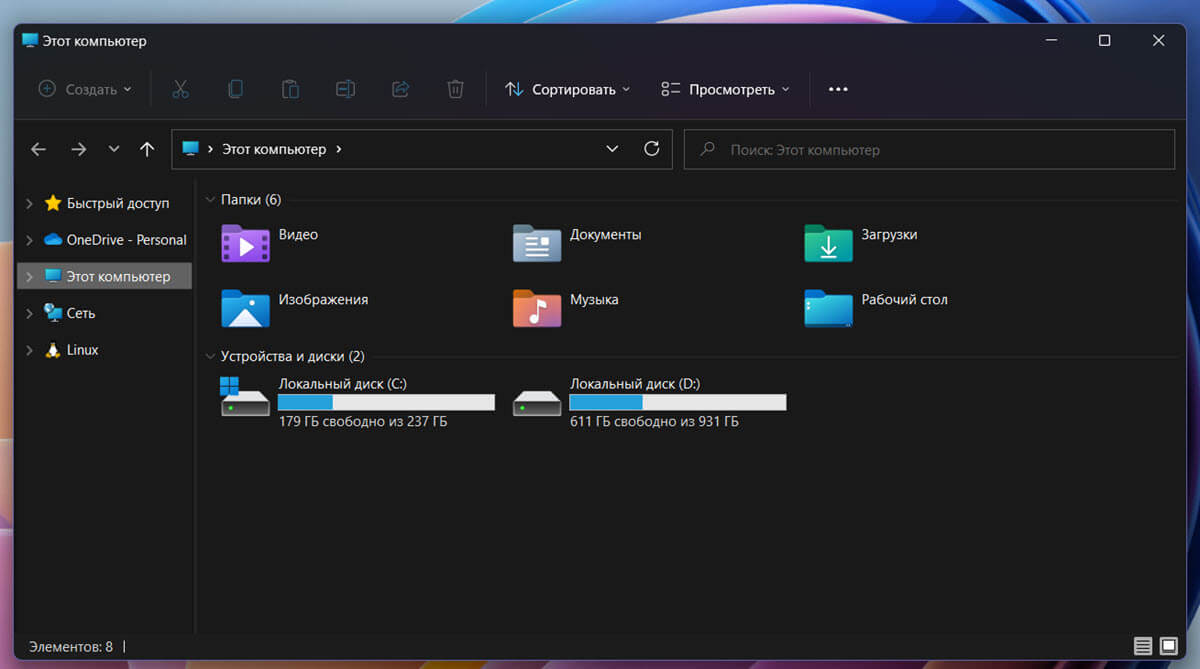
Шаг 2: Затем дважды кликните диск, на котором установлена Windows 11, чтобы открыть его.
Шаг 3: В следующем окне, найдите в списке папку «Program Files» и дважды кликните по ней, чтобы открыть.
Шаг 4: После этого в меню окна проводника нажмите значок с многоточием (три горизонтальные точки). Затем в контекстном меню выберите опцию «Параметры». На вашем экране откроется отдельное окно.
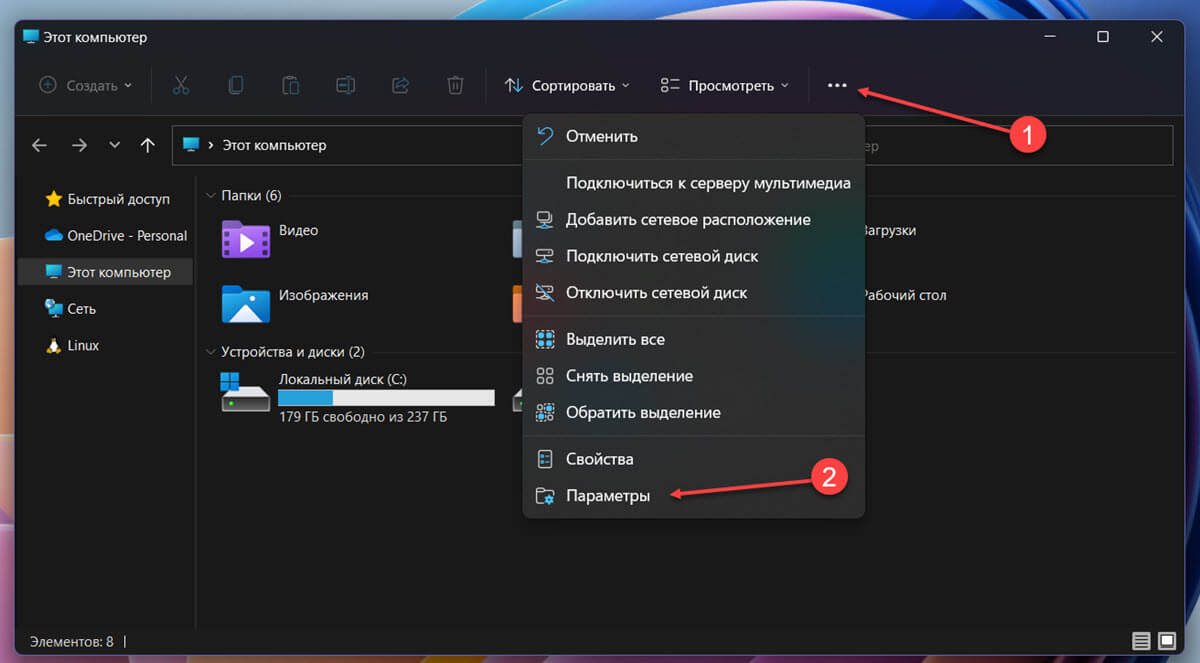
Шаг 5: В отдельно открывшемся окне перейдите на вкладку «Вид» и найдите параметр «Скрытые файлы и папки» в разделе «Дополнительные параметры:». Затем установите флажок перед строкой «Показывать скрытые файлы, папки и диски».

Шаг 6: Нажмите кнопку «Применить», чтобы сохранить изменения, а затем нажмите кнопку «ОК», чтобы закрыть окно.
Примечание: В качестве альтернативы есть более простой способ показать скрытые папки. В меню проводника выберите опцию «Просмотреть». Затем наведите в контекстном меню указатель мыши на опцию «Показать» и нажмите на опцию «Скрытые элементы».
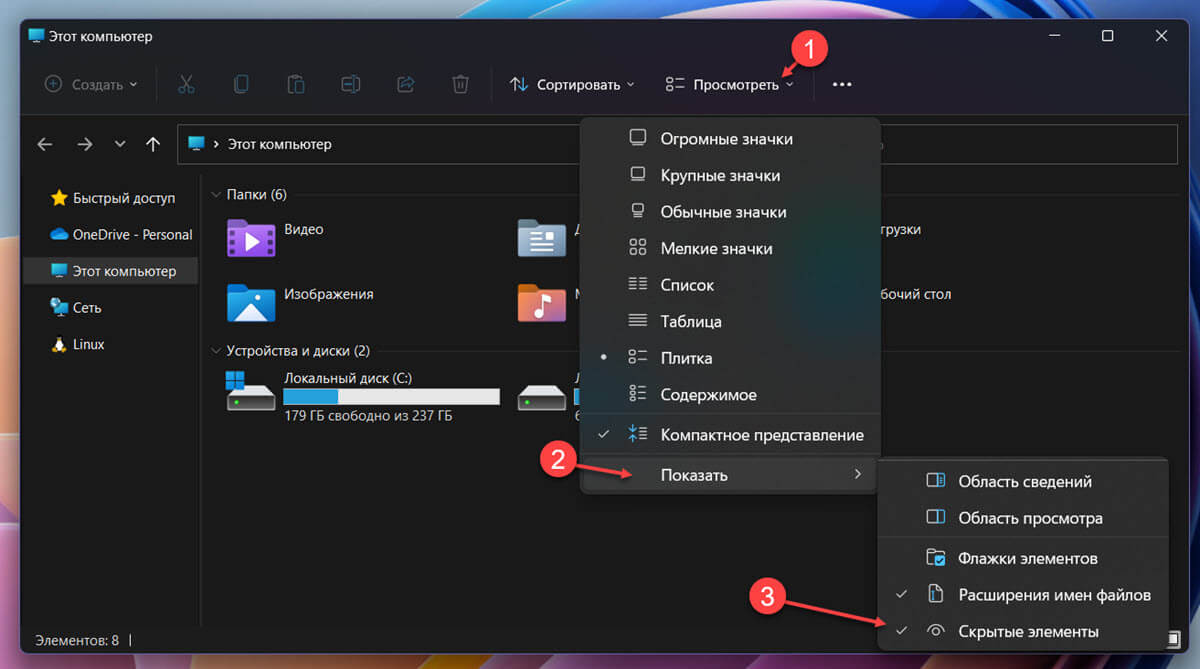
Шаг 7: После этого найдите папку «WindowsApps» и дважды кликните по ней, чтобы продолжить.
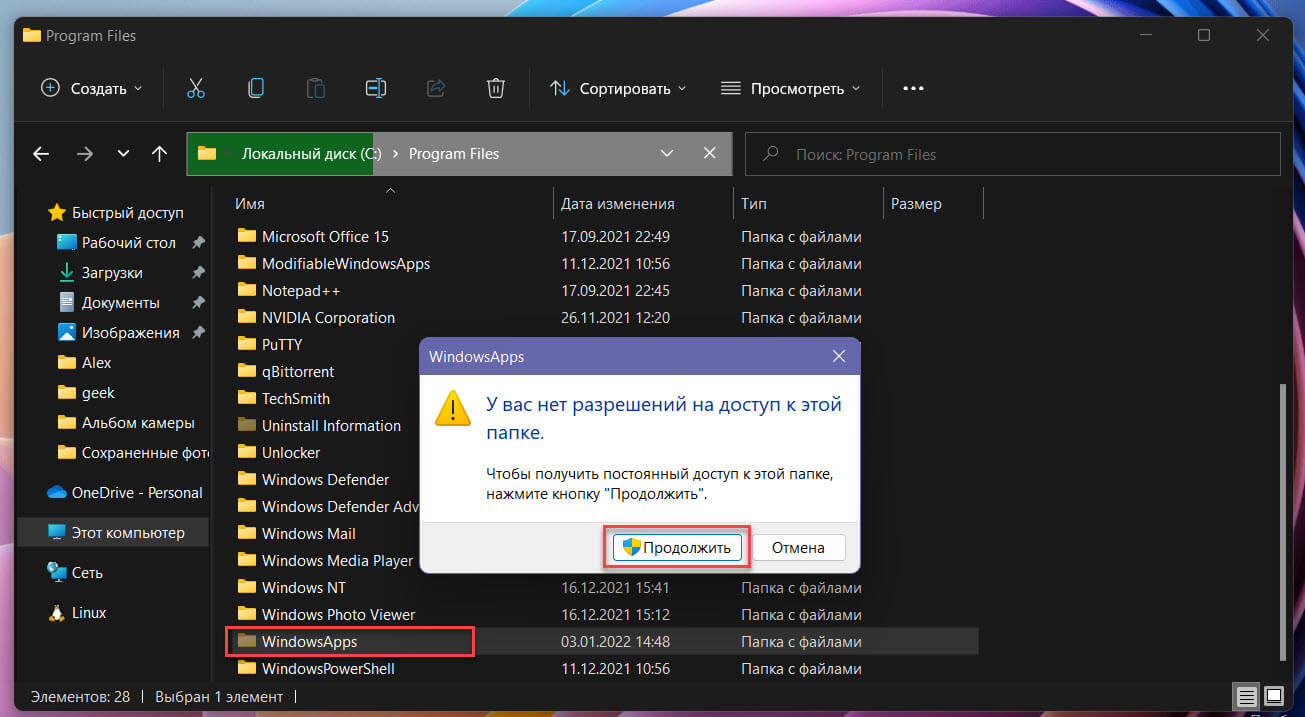
Шаг 8: На вашем экране появится сообщение о том, что у вас нет разрешения на доступ к папке. Нажмите в приглашении кнопку «Продолжить».
Шаг 9: Снова появляется уведомление о том, что вам отказано в доступе; нажмите ссылку (вкладку «Безопасность»), чтобы продолжить. На вашем экране откроется отдельное окно.
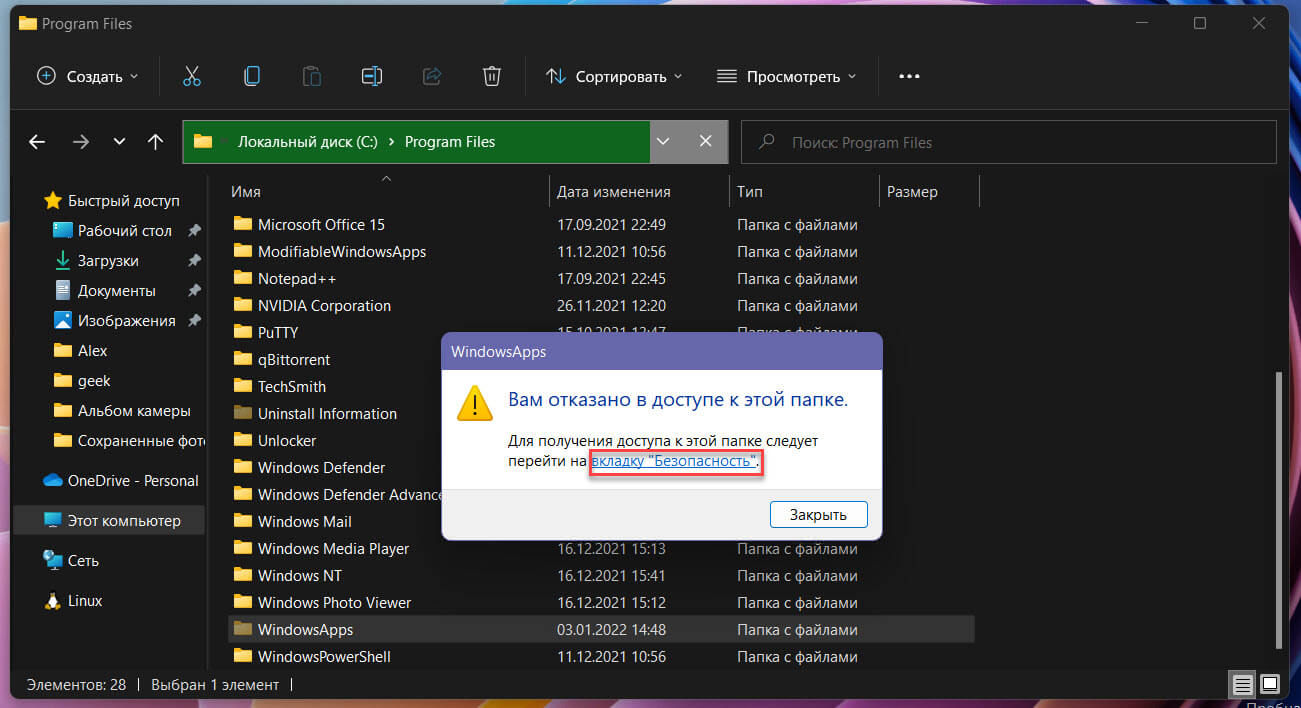
Шаг 10: После этого в окне «Свойства WindowsApps» нажмите кнопку «Дополнительно», чтобы настроить разрешения для доступа к папке. Это снова откроет отдельное окно на вашем экране.
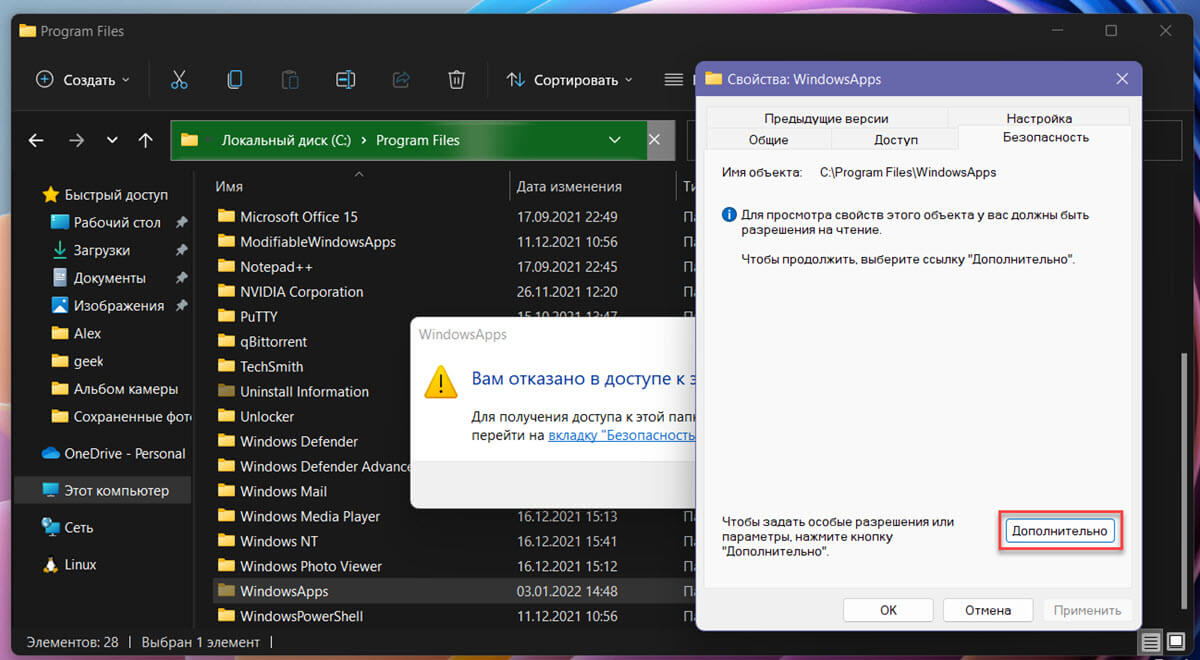
Шаг 11: Затем в «Расширенных настройках безопасности» нажмите кнопку «Изменить» рядом с меткой «Владелец». Откроется окно «Выбор пользователь или группа».
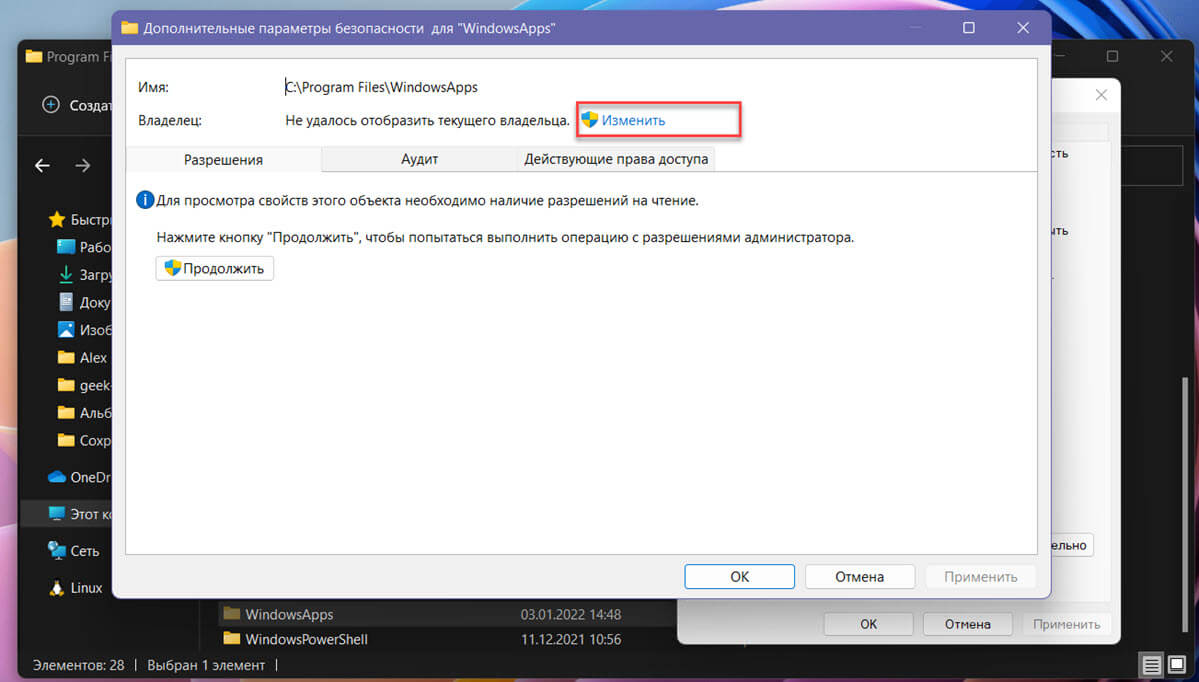
Шаг 12: В окне «Выбор пользователь или группа» нажмите кнопку «Дополнительно…» в нижнем левом углу окна. Это действие снова вызовет отдельное окно.

Шаг 13: Теперь в отдельно открытом окне нажмите кнопку «Поиск», чтобы продолжить. Это заполнит список в разделе «Результаты поиска» ниже.
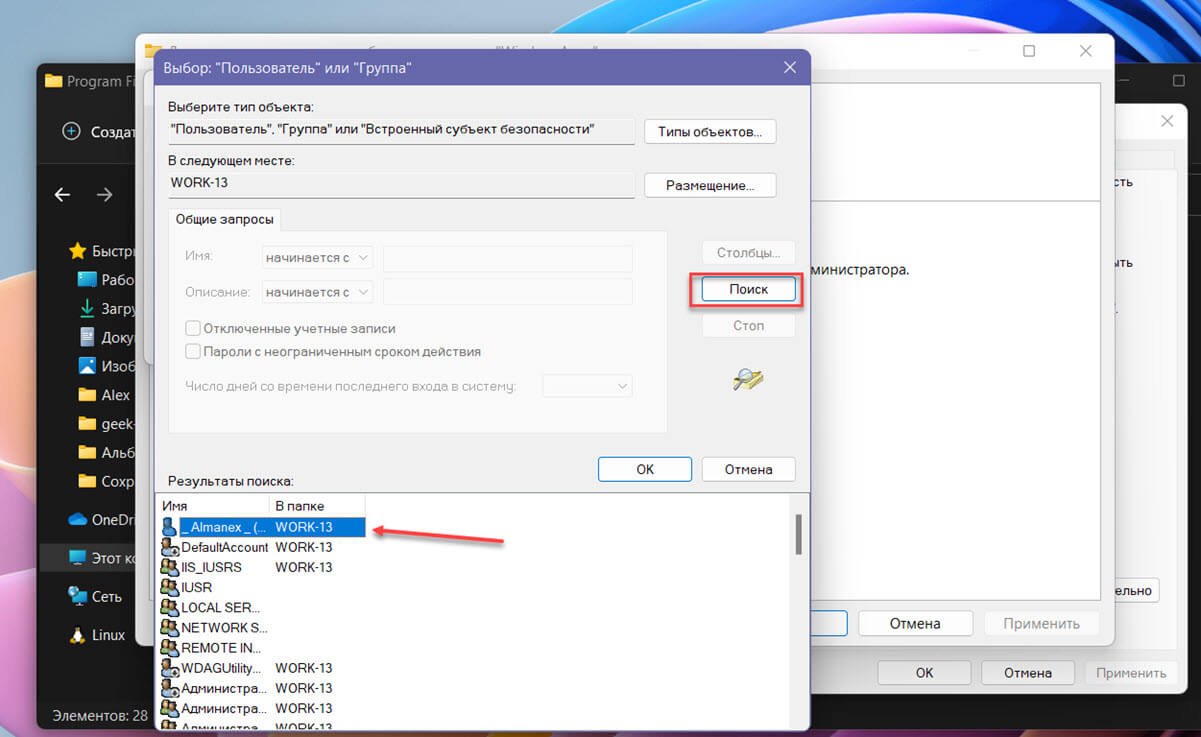
Шаг 14: После этого выберите свое имя пользователя / имя учетной записи из списка и нажмите кнопку «ОК», чтобы выбрать пользователя и закрыть окно.
Шаг 15: Затем в разделе «Выбор пользователь или группа» еще раз нажмите кнопку «ОК», чтобы сменить владельца папки «WindowsApps» и закрыть окно.
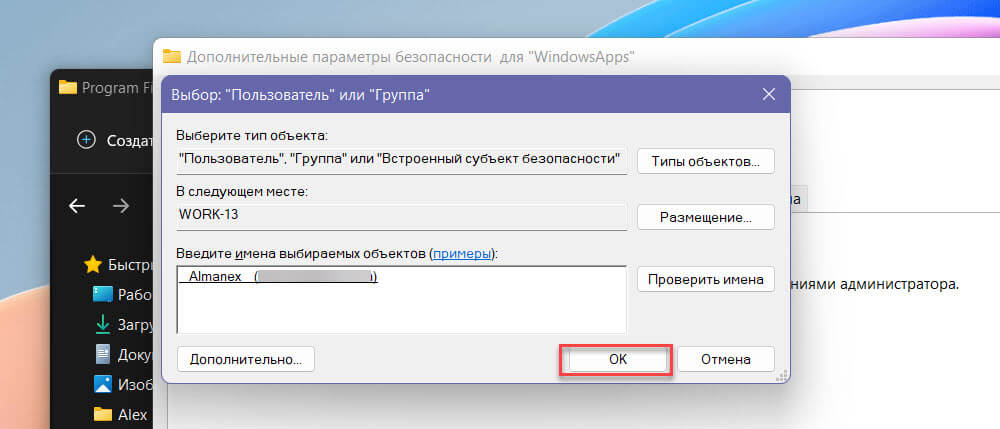
Шаг 16: Теперь в окне «Дополнительные параметры безопасности» для WindowsApps вы сможете подтвердить смену владельца папки. При необходимости установите флажок для опции «Заменить владельца подконтейнеров и объектов». Нажмите кнопку «Применить», чтобы сохранить изменения, и нажмите кнопку «ОК», чтобы закрыть окно.
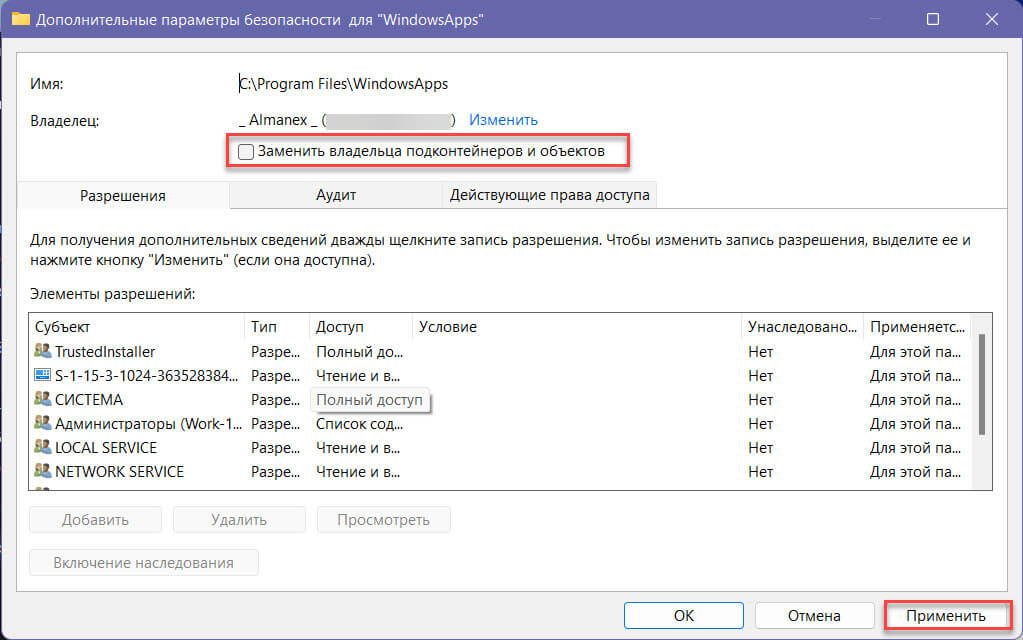
Вы увидите уведомление о том что вы стали владельцем этого объекта.
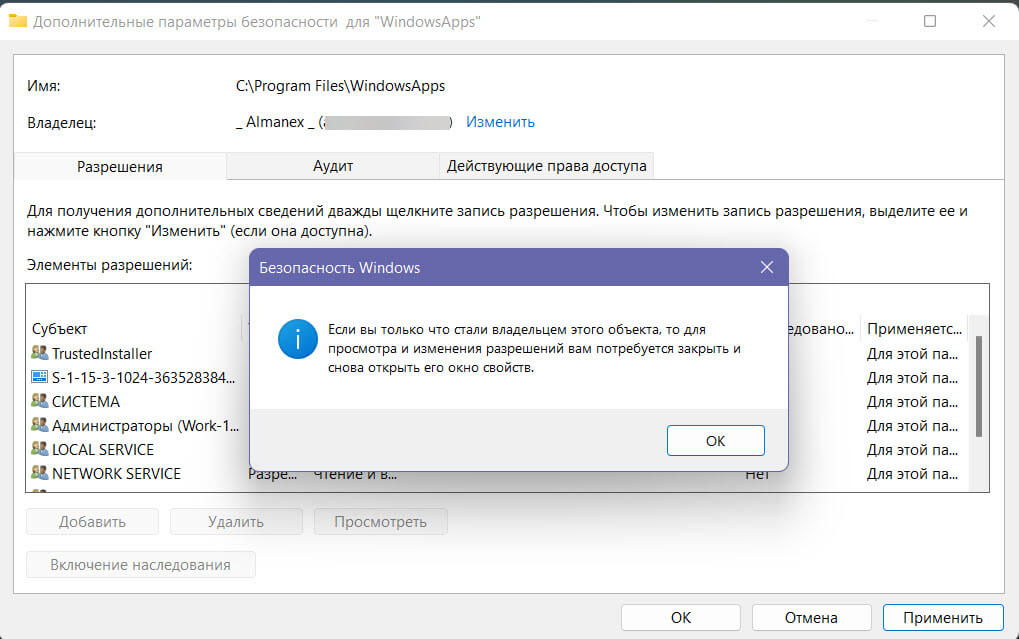
Шаг 17: Все, Вы справились, дважды кликните папку «WindowsApps», и она откроется как обычная папка.
Рекомендуем:
- Как восстановить владельца TrustedInstaller в Windows 11 \ 10
- Как получить полный доступ к конкретной записи реестра для редактирования или удаления

